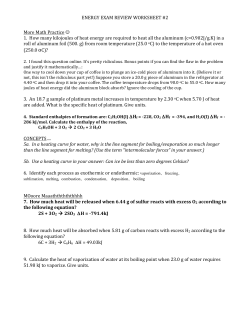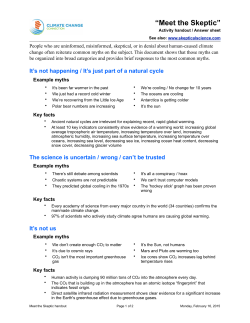
- ePIC
Nova Acta Leopoldina NF 121, Nr. 408, 59 – 63 (2015) Latest Insights into Past Carbon Cycle Changes from CO2 and δ13Catm Hubertus Fischer,1, 2 Jochen Schmitt,1,2 Robert Schneider,1 Sarah S. Eggleston,1 Fortunat Joos,1 Thomas K. Bauska,3 Shaun A. Marcott,3,4 Edward J. Brook,3 Peter Köhler,2 and Jérôme Chappellaz5 With 2 Figures CO2 represents the most important greenhouse gas released into the atmosphere as a result of human activity. The majority of our knowledge on the increase in CO2 since the start of the industrialization comes from ice cores, which complement the direct atmospheric CO2 measurements obtained at Mauna Loa since the 1950s. The combined CO2 record shows an unambiguous anthropogenic CO2 increase over the last 150 years from 280 to about 400 ppm in 2014. Values above 300 ppm are unprecedented in the long-term ice core record covering the last 800,000 years, with natural CO2 concentrations varying between interglacial and glacial bounds of about 280 and 180 ppm, respectively (Lüthi et al. 2008, Petit et al. 1999). Moreover, the increase in CO2 concentrations during the last termination shows significant fine structure (Marcott et al. 2014, Monnin et al. 2001), indicating a sequence of events of CO2 release to the atmosphere involving different processes acting at different points in time. Although past atmospheric CO2 concentrations are known with high precision, the causes of the observed deglacial CO2 changes cannot be easily attributed quantitatively to individual processes and the cause of the glacial/interglacial 80 –100 ppm increase of atmospheric CO2 remains a hot topic of paleoclimate research. Several processes have been implied (Brovkin et al. 2012, Ciais et al. 2012, Fischer et al. 2010, Jaccard et al. 2013, Köhler and Fischer 2006, Martínez-García et al. 2009, Menviel et al. 2012, Stephens and Keeling 2000, Toggweiler et al. 2006, Tschumi et al. 2011, Watson and Garabato 2006). These include: – – – – – – – Southern Ocean ventilation by wind or buoyancy feedbacks, Iron fertilization of the marine biosphere in the Southern Ocean, Changes in the re-mineralization depth of organic carbon, Release of permafrost carbon during the deglaciation, Decreased solubility due to ocean warming, Changes in air/sea gas exchange due to changing sea ice cover, Marine carbonate feedbacks. 1 Climate and Environmental Physics, Physics Institute & Oeschger Centre for Climate Change Research, University of Bern, Switzerland, hubertus.fischer@climate.unibe.ch. 2 Alfred-Wegener-Institut Helmholtz-Zentrum für Polar-und Meeresforschung (AWI), Bremerhaven, Germany. 3 College of Earth, Ocean, and Atmospheric Sciences, Oregon State University, Corvallis, OR, USA. 4 Department of Geoscience, University of Wisconsin, Madison, WI, USA. 5 Laboratoire de Glaciologie et Geophysique de l’Environment, CNRS, Grenoble, France. 59 Hubertus Fischer et al. However, none of these processes alone is able to explain the glacial/interglacial CO2 change. Substantial progress could come from better estimates of past changes in the carbon stored by the biosphere or from using stable carbon isotopes to constrain sources and sinks of carbon and exchange processes with the atmosphere. The vast majority of the carbon cycling in the Earth system on multi-millennial timescales resides in the ocean. Accordingly, the global δ13C of inorganic carbon dissolved in seawater (δ13CDIC) may provide the best constraint on past carbon cycle changes (Goodwin et al. 2011). However, a global compilation of δ13CDIC from marine sediment records is hampered by insufficient spatial representation of vast ocean regions, the limited temporal resolution of many sediment records, and substantial chronologic uncertainties. The alternative, to reconstruct the mean δ13C record of the well-mixed atmosphere (δ13Catm) from the fossil air contained in Antarctic ice cores has been a long-standing Fig. 1 Deglacial record of atmospheric changes in CO2 (Marcott et al. 2014, Monnin et al. 2001) and δ13Catm (Schmitt et al. 2012) and Bauska et al. (in preparation). The arrows indicate the approximate glacial/interglacial changes expected from individual carbon cycle processes according to Köhler et al. 2005: Changes in sea surface temperature (dark blue), Southern Ocean ventilation (blue), iron fertilization (red), terrestrial biosphere regrowth (green) and carbonate compensation (black). 60 Nova Acta Leopoldina NF 121, Nr. 408, 59 – 63 (2015) Latest Insights into Past Carbon Cycle Changes from CO2 and δ13Catm quest, and only latest analytical progress was able to improve the measurement error while at the same time cutting down sample size by an order of magnitude. The new δ13Catm data from the air trapped in Antarctic ice cores, provides improved constraints to revisit the enigma of deglacial CO2 increase (Fig. 1). Mean δ13Catm levels during the Last Glacial Maximum and the Holocene (as well as for MIS6 and MIS5.5) are surprisingly similar, despite different CO2 concentrations and the substantially altered climate system. This supports again the notion that the δ13Catm record is the sum of several factors that balance each other to a large extent as shown in Figure 1. The δ13Catm data (Lourantou et al. 2010a, b, Schmitt et al. 2012, Schneider et al. 2013) from the last two deglaciations suggest a sequence of processes that drove atmospheric CO2 changes during different stages of the transition from glacial conditions into a milder interglacial world. At the start of the transitions, upwelling of old 13C-depleted waters in the Southern Ocean increased the release of CO2 to the atmosphere. This process was synchronous with a demise in iron-stimulated bioproductivity in the Southern Ocean, when atmospheric dust concentrations declined rapidly. This carbon release from the ocean was followed by the gradual growth of terrestrial carbon storage in vegetation, soil, and peatlands as evidenced by the slow δ13Catm increase. This process reached well into the subsequent interglacials. While the well-studied glacial terminations indicate a release of old, isotopically depleted carbon from the deep ocean, it is not yet known unambiguously, when this carbon has been transferred to the deep ocean and where this old carbon has been stored. Again δ13Catm data Fig. 2 Record of atmospheric CO2 (Bereiter et al. 2012) and δ13Catm (Schmitt et al. 2012, Schneider et al. 2013) (orange) and Eggleston et al. (blue, in preparation). δ13Catm data points from brittle ice show negative outliers due to drill fluid contamination. The background indicates the two mode carbon cycle changes in the Southern Ocean (reduced ventilation in the Antarctic Zone [orange] vs. increased iron fertilization in the Subantarctic Zone [light blue] as defined by Jaccard et al. 2005). Nova Acta Leopoldina NF 121, Nr. 408, 59 – 63 (2015) 61 Hubertus Fischer et al. covering the entire last glacial cycle can answer the first of these questions. Latest results from Antarctic ice cores show a gradual increase in δ13Catm over the entire MIS5 and 4, which culminated during an upwelling event (Anderson et al. 2009) observed at the MIS4/3 transition, similar to the one encountered during the last termination. Interestingly, during the MIS5/4 transition, when iron fertilization was most likely to set in, as indicated by the strong increase in iron bearing eolian mineral dust aerosol (Lambert et al. 2012, Martínez-García et al. 2009, Wolff et al. 2006), no clear increase in δ13Catm is found. This provides an experimental upper bound on the amount of CO2 reduction by iron fertilization at this time. Again over MIS3 a similar long-term enrichment in δ13Catm is observed which ends with the upwelling event at the beginning of termination I (Anderson et al. 2009). Superimposed on these changes in carbon storage in the abyss, a long-term trend in δ13Catm can also be discerned leading to 0.4 ‰ lighter values in MIS6 compared to the Last Glacial Maximum as well as in MIS5.5 compared to the Holocene. Similar offsets are also seen in marine δ13CDIC records suggesting long-term changes in the isotopic composition of the entire ocean/atmosphere carbon pool (Schneider et al. 2013). References Anderson, R. F., Ali, S., Bradtmiller, L. I., Nielsen, S. H. H., Fleisher, M. Q., Anderson, B. E., and Burckle, L. H.: Wind-driven upwelling in the Southern Ocean and the deglacial rise in atmospheric CO2. Science 323, 1443 –1448 (2009) Bereiter, B., Lüthi, D., Siegrist, M., Schüpbach, S., Stocker, T. F., and Fischer, H.: Mode change of millennial CO2 variability during the last glacial cycle associated with a bipolar marine carbon seesaw. Proc. Natl. Acad. Sci. USA 109, 9755 –9760 (2012) Brovkin, V., Ganopolski, A., Archer, D., and Munhoven, G.: Glacial CO2 cycle as a succession of key physical and biogeochemical processes. Clim. Past 8, 251–264 (2012) Ciais, P., Tagliabue, A., Cuntz, M., Bopp, L., Scholze, M., Hoffman, G., Lourantou, A., Harrison, S. P., Prentice, I. C., Kelley, D. I., Koven, C., and Piao, S. L.: Large inert carbon pool in the terrestrial biosphere during the Last Glacial Maximum. Nature Geosci. 5, 74 –79 (2012) Fischer, H., Schmitt, J., Lüthi, D., Stocker, T. F., Tschumi, T., Parekh, P., Joos, F., Köhler, P., Völker, C., Gersonde, R., Barbante, C., Le Floch, M., Raynaud, D., and Wolff, E.: The role of Southern Ocean processes in orbital and millennial CO2 variations – A synthesis. Quat. Sci. Rev. 29, 193 –205 (2010) Goodwin, P., Oliver, K. I. C., and Lenton, T. M.: Observational constraints on the causes of Holocene CO2 change. Global Biogeochem. Cycles 25, GB3011; doi: 10.1029/2010GB003888 (2011) Jaccard, S. L., Haug, G. H., Sigman, D. M., Pedersen, T. F., Thierstein, H. R., and Röhl, U.: Glacial/interglacial changes in Subarctic North Pacific stratification. Science 308, 1003 –1006 (2005) Jaccard, S. L., Hayes, C. T., Martínez-García, A., Hodell, D. A., Anderson, R. F., Sigman, D. M., and Haug, G. H.: Two modes of change in Southern Ocean productivity over the past million years. Science 339, 1419 –1423 (2013) Köhler, P., and Fischer, H.: Simulating low frequency changes in atmospheric CO2 during the last 740,000 years. Clim. Past 2, 57–78 (2006) Köhler, P., Fischer, H., Munhoven, G., and Zeebe, R. E.: Quantitative interpretation of atmospheric carbon records over the last glacial termination. Global Biogeochem. Cycles 19, GB4020; doi:10.1029/2004GB002345 (2005) Lambert, F., Bigler, M., Steffensen, J. P., Hutterli, M., and Fischer, H.: Centennial mineral dust variability in high-resolution ice core data from Dome C, Antarctica. Clim. Past 8, 609 – 623 (2012) Lourantou, A., Chappellaz, J., Barnola, J.-M., Masson-Delmotte, V., and Raynaud, D.: Changes in atmospheric CO2 and its carbon isotopic ratio during the penultimate deglaciation. Quat. Sci. Rev. 29, 1983 –1992 (2010a) Lourantou, A., Lavric, J., Köhler, P., Barnola, J.-M., Paillard, D., Michel, E., Raynaud, D., and Chappellaz, J.: Constraint of the CO2 rise by new atmospheric carbon isotopic measurements during the last deglaciation. Global Biogeochem. Cycles 24, GB2015; doi:10.1029/2009GB003545 (2010b) 62 Nova Acta Leopoldina NF 121, Nr. 408, 59 – 63 (2015) Latest Insights into Past Carbon Cycle Changes from CO2 and δ13Catm Lüthi, D., Le Floch, M., Bereiter, B., Blunier, T., Barnola, J.-M., Siegenthaler, U., Raynaud, D., Jouzel, J., Fischer, H., Kawamura, K., and Stocker, T. F.: High-resolution carbon dioxide concentration record 650,000 – 800,000 years before present. Nature 453, 379 –382 (2008) Marcott, S. A., Bauska, T. K., Buizert, C., Steig, E. J., Rosen, J. L., Cuffey, K. M., Fudge, T. J., Severinghaus, J. P., Ahn, J., Kalk, M. L., McConnell, J. R., Sowers, T., Taylor, K. C., White, J. W. C., and Brook, E. J.: Centennial-scale changes in the global carbon cycle during the last deglaciation. Nature 514, 616 – 619 (2014) Martínez-García, A., Rosell-Melé, A., Geibert, W., Gersonde, R., Masqué, P., Gaspari, V., and Barbante, C.: Links between iron supply, marine productivity, sea surface temperature and CO2 over the last 1.1 My. Paleoceanography 24, PA1207; doi:10.1029/2008PA001657 (2009) Menviel, L., Joos, F., and Ritz, S. P.: Simulating atmospheric CO2, 13C and the marine carbon cycle during the last glacial/interglacial cycle: possible role for a deepening of the mean remineralization depth and an increase in the oceanic nutrient inventory. Quat. Sci. Rev. 56, 46 – 68 (2012) Monnin, E., Indermühle, A., Dällenbach, A., Flückiger, J., Stauffer, B., Stocker, T. F., Raynaud, D., and Barnola, J.-M.: Atmospheric CO2 concentration over the last termination. Science 291, 112–114 (2001) Petit, J. R., Jouzel, J., Raynaud, D., Barkov, N. I., Barnola, J.-M., Basile, I., Bender, M., Chappellaz, J., Davis, M., Delaygue, G., Delmotte, M., Kotlyakov, V. M., Legrand, M., Lipenkov, V. Y., Lorius, C., Pepin, L., Ritz, C., Saltzman, E., and Stievenard, M.: Climate and atmospheric history of the past 420,000 years from the Vostok ice core, Antarctica. Nature 399, 429 – 436 (1999) Schmitt, J., Schneider, R., Elsig, J., Leuenberger, D., Lourantou, A., Chappellaz, J., Köhler, P., Joos, F., Stocker, T. F., Leuenberger, M., and Fischer, H.: Carbon isotope constraints on the deglacial CO2 rise from ice cores. Science 336, 711–714 (2012) Schneider, R., Schmitt, J., Köhler, P., Joos, F., and Fischer, H.: A reconstruction of atmospheric carbon dioxide and its stable carbon isotopic composition from the penultimate glacial maximum to the last glacial inception. Clim. Past 9, 2507–2523 (2013) Stephens, B. B., and Keeling, R. F.: The influence of Antarctic sea ice on glacial-interglacial CO2 variations. Nature 404, 171–174 (2000) Toggweiler, J. R., Russell, J. L., and Carson, S. R.: Midlatitude westerlies, atmospheric CO2, and climate change during the ice ages. Paleoceanography 21, PA2005; doi:10.1029/2005PA001154 (2006) Tschumi, T., Joos, F., Gehlen, M., and Heinze, C.: Deep ocean ventilation, carbon isotopes, marine sedimentation and the deglacial CO2 rise. Clim. Past 7, 771– 800 (2011) Watson, A. J., and Garabato, A. C. N.: The role of Southern Ocean mixing and upwelling in glacial-interglacial atmospheric CO2 change. Tellus 58B, 73 – 87 (2006) Wolff, E. W., Fischer, H., Fundel, F., Ruth, U., Twarloh, B., Littot, G. C., Mulvaney, R., Angelis, M. de, Boutron, C. F., Hansson, M., Jonsell, U., Hutterli, M., Bigler, M., Lambert, F., Kaufmann, P., Röthlisberger, R., Steffensen, J. P., Siggaard-Andersen, M.-L., Udisti, R., Becagli, S., Castellano, E., Severi, M., Wagenbach, D., Barbante, C., Gabrielli, P., and Gaspari, V.: Southern Ocean sea ice, DMS production and iron flux over the last eight glacial cycles. Nature 440, 491– 496 (2006) Prof. Dr. Hubertus Fischer Climate and Environmental Physics Physics Institute & Oeschger Centre for Climate Change Research University of Bern Sidlerstrasse 5 CH-3012 Bern Switzerland Phone: +41 31 6318503 Fax: +41 31 6318742 E-Mail:hubertus.fischer@climate.unibe.ch Nova Acta Leopoldina NF 121, Nr. 408, 59 – 63 (2015) 63
© Copyright 2025











